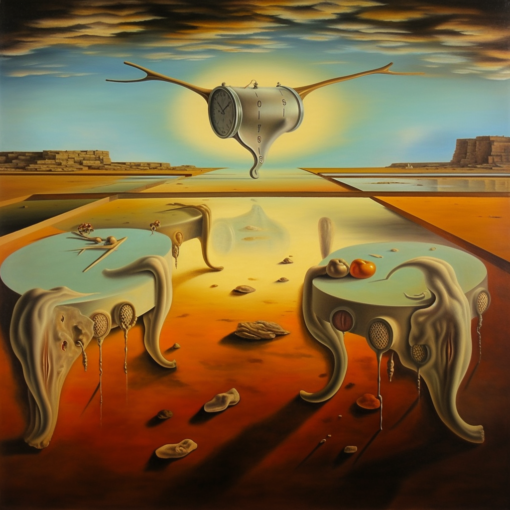Hello, fellow adventurers! Percival here, your humble guide through the mysteries and wonders of the world. Today, we embark on an artistic expedition into the enigmatic realm of M.C. Escher, an artist whose mathematical precision and fantastical imagination converged to create some of the most intriguing art pieces in history.
Maurits Cornelis Escher was born in Leeuwarden, Netherlands, in 1898. From his early years, Escher showed an affinity for drawing and was particularly fascinated with nature and the Italian countryside. But the core of his art, the aspect that would seal his place in the annals of art history, lay in his exploration of geometric patterns, tessellations, and impossible spaces.
Imagine a waterfall that flows uphill, fish that morph into birds, hands that draw themselves, or staircases that defy gravity and loop eternally. Such are the images that populate the Escher universe, a place where reality is but a loose thread that the artist weaves, unwinds, and stitches back together in ways that playfully mock our understanding of the physical world.
Yet, there’s more than just visual trickery in Escher’s art. His prints and drawings often incorporate complex mathematical principles. Tessellations, or the art of fitting shapes together without any gaps, frequently appear in his work. So too does the concept of infinity, a motif represented both in his use of endless staircases and in his exploration of the infinitely small or large.
Escher’s artworks, such as “Relativity,” “Drawing Hands,” and “Ascending and Descending,” are not just mind-bending optical illusions, but thoughtful commentaries on the human condition. His paradoxical spaces might symbolize the complexity of the individual’s mind, the relativity of one’s perspective, or the cyclic and often paradoxical nature of existence.
So, dear reader, as we wander through the intriguing labyrinth of Escher’s art, let us not merely marvel at its technical genius or the way it toys with our perception. Instead, let us seek to understand the questions his work raises about reality, perception, and our place in the universe. Herein lies the true magic of M.C. Escher – a visual journey that stimulates, challenges, and ultimately enriches our minds.
Until our next adventure,
Percival





28 thoughts on “The Mind-Bending World of M.C. Escher: A Dive into the Infinite”
Very well presented. Every quote was awesome and thanks for sharing the content. Keep sharing and keep motivating others.
What i do not understood is in truth how you are not actually a lot more smartlyliked than you may be now You are very intelligent You realize therefore significantly in the case of this topic produced me individually imagine it from numerous numerous angles Its like men and women dont seem to be fascinated until it is one thing to do with Woman gaga Your own stuffs nice All the time care for it up
Thank you for your sharing. I am worried that I lack creative ideas. It is your article that makes me full of hope. Thank you. But, I have a question, can you help me? https://accounts.binance.info/en/register?ref=JHQQKNKN
equilibrador
Aparatos de ajuste: fundamental para el rendimiento uniforme y óptimo de las maquinarias.
En el campo de la avances avanzada, donde la efectividad y la confiabilidad del dispositivo son de suma relevancia, los dispositivos de equilibrado cumplen un papel crucial. Estos dispositivos especializados están desarrollados para balancear y estabilizar piezas giratorias, ya sea en dispositivos de fábrica, medios de transporte de traslado o incluso en aparatos domésticos.
Para los expertos en soporte de equipos y los profesionales, operar con aparatos de balanceo es fundamental para promover el operación estable y fiable de cualquier dispositivo móvil. Gracias a estas soluciones innovadoras modernas, es posible limitar notablemente las oscilaciones, el estruendo y la carga sobre los sujeciones, mejorando la vida útil de partes caros.
También relevante es el tarea que tienen los dispositivos de equilibrado en la servicio al cliente. El soporte técnico y el soporte permanente usando estos equipos habilitan brindar servicios de gran estándar, aumentando la agrado de los clientes.
Para los propietarios de emprendimientos, la financiamiento en sistemas de equilibrado y dispositivos puede ser esencial para mejorar la efectividad y desempeño de sus aparatos. Esto es principalmente relevante para los dueños de negocios que manejan reducidas y pequeñas negocios, donde cada aspecto vale.
También, los dispositivos de equilibrado tienen una gran uso en el área de la protección y el supervisión de estándar. Posibilitan localizar probables problemas, reduciendo arreglos caras y problemas a los equipos. También, los información obtenidos de estos equipos pueden utilizarse para mejorar métodos y aumentar la reconocimiento en plataformas de búsqueda.
Las áreas de aplicación de los equipos de ajuste cubren variadas sectores, desde la fabricación de transporte personal hasta el control del medio ambiente. No importa si se refiere de grandes fabricaciones industriales o pequeños establecimientos caseros, los dispositivos de equilibrado son fundamentales para proteger un rendimiento óptimo y libre de fallos.
Your point of view caught my eye and was very interesting. Thanks. I have a question for you.
Your point of view caught my eye and was very interesting. Thanks. I have a question for you.
Thanks for sharing. I read many of your blog posts, cool, your blog is very good.
Your article helped me a lot, is there any more related content? Thanks! https://www.binance.info/ru-UA/register?ref=OMM3XK51
Harika bir yazı olmuş, teşekkürler. Özellikle Bursa’nın yoğun trafiğinde neyle karşılaşacağımız belli olmuyor. Olası bir durumda elimde kanıt olması için kaliteli bir bursa araç kamerası almayı düşünüyorum. Bu yazı karar vermemde çok yardımcı oldu.
Harika bir yazı olmuş, teşekkürler. Özellikle Bursa’nın yoğun trafiğinde neyle karşılaşacağımız belli olmuyor. Olası bir durumda elimde kanıt olması için kaliteli bir bursa araç kamerası almayı düşünüyorum. Bu yazı karar vermemde çok yardımcı oldu.
Thank you for your sharing. I am worried that I lack creative ideas. It is your article that makes me full of hope. Thank you. But, I have a question, can you help me? binance
Your article helped me a lot, is there any more related content? Thanks!
Can you be more specific about the content of your article? After reading it, I still have some doubts. Hope you can help me.
**mind vault**
mind vault is a premium cognitive support formula created for adults 45+. It’s thoughtfully designed to help maintain clear thinking
**sugarmute**
sugarmute is a science-guided nutritional supplement created to help maintain balanced blood sugar while supporting steady energy and mental clarity.
**glpro**
glpro is a natural dietary supplement designed to promote balanced blood sugar levels and curb sugar cravings.
**zencortex**
zencortex contains only the natural ingredients that are effective in supporting incredible hearing naturally.
**mitolyn**
mitolyn a nature-inspired supplement crafted to elevate metabolic activity and support sustainable weight management.
**yu sleep**
yusleep is a gentle, nano-enhanced nightly blend designed to help you drift off quickly, stay asleep longer, and wake feeling clear.
**prodentim**
prodentim an advanced probiotic formulation designed to support exceptional oral hygiene while fortifying teeth and gums.
**synaptigen**
synaptigen is a next-generation brain support supplement that blends natural nootropics, adaptogens
**vittaburn**
vittaburn is a liquid dietary supplement formulated to support healthy weight reduction by increasing metabolic rate, reducing hunger, and promoting fat loss.
**nitric boost**
nitric boost is a dietary formula crafted to enhance vitality and promote overall well-being.
**glucore**
glucore is a nutritional supplement that is given to patients daily to assist in maintaining healthy blood sugar and metabolic rates.
**wildgut**
wildgutis a precision-crafted nutritional blend designed to nurture your dog’s digestive tract.
**breathe**
breathe is a plant-powered tincture crafted to promote lung performance and enhance your breathing quality.
Decent casino experience on codwincasino. The live games are pretty good, and the customer support is responsive. Give codwincasino a try if you’re after something new.
Anyone remember playing Fish Prawn Crab as a kid? Happy to see it’s online now! fishprawncrab1 seems like a fun place to relive those memories and maybe win some cash. Check out fishprawncrab1!